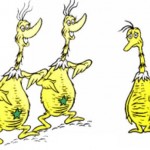Interpersonal relationships and race; many times I have mentioned that course.Â
   You may have wondered why I focus on the interpersonal when it comes to (what seem to be) racial matters. Anytime I have discussed neo-diversity, the reason has been implied. But to be direct the reason for the interpersonal focus is that interacting with each other remains our great racial, ethnic, gender, religious, challenge.Â
      Fast and dramatic social changes have put us in the same situation as Dr. Seuss’ Sneetches.
   We rid ourselves of the immoral racial laws of segregation. With that change and other changes in the social world, we were no longer able to say “…well they can’t come in hereâ€; they can’t come to our frankfurter parties. With that some yelled out like Dr. Seuss’s Starbelly Sneetches did:
 “Good grief!â€groaned the ones who had stars at the first…
“We’re still the best Sneetches and they are the worst.
But, now, how in the world will we know,â€they all frowned,
“If which kind is what, or the other way round?â€
     Caught off guard by the changes, we began our struggle with neo-diversity. And we sent our children out into that neo-diversity unprepared and without hope of getting aid.Â
     2006 is when I created and first taught the course, Interpersonal Relationships and race. Why did I create the course? What was my motivation? In the Spring 2004, in my introduction to social psychology course, I was teaching the section on race as an interpersonal phenomenon. I teach this topic late in the semester because I want students to have gotten to know me. Otherwise having me, a 6’3â€, 280 lb., dark-skinned black man as the professor might dampen the discussion of race relations. To a certain degree that strategy had worked in the past, but this time the class of 200, mostly white, students froze up. The tension in the room was palpable. Discussion was strained.
   After class, I returned to my office. I sat and waited for a student from that class to show up for a previously arranged appointment. When this young white female came into my office, after she took her seat, and we exchanged our quick hellos I said,
    “Sorry but before we get to your questions, I have a question.â€
    She looked at me as if to say, “I knew he was going to do this.â€
    By that point in the semester, my students know me well. That means they know that I notice things and will ask about what I think is going on.
    “Did you feel that in the class today?â€
   Still looking at me in that way, she hesitated.
    “Yes…†she finally said.
    “What was that,†I asked.
    She looked into my eyes then dropped her gaze to the floor. I waited. Again, she looked up, dropped her gaze briefly then looked back up at me.
   “Everybody says we have to be more accepting,†she said. “But nobody tells us what that means.â€
   Profound… this was a profound statement about the state of race-relations and diversity on our campus and elsewhere. During orientation, colleges and universities tell students that the campus is one that has and accepts all kinds of people. Students are told that they too have to accept all kinds of people. But, as this young woman said, nobody tells students what that means.        Â
    It turns out that even as America becomes more and more diverse, nobody tells citizens what that means. And so Americans are struggling with how to manage their day to day interpersonal lives because the old racial, gender, ethnic rules do not apply. Without laws and social understandings prohibiting who can go where, we all find ourselves interacting with people from other American racial, ethnic, gender and religion groups. We struggle then with the question, “who are among the ‘we’ and who among the ‘they’?â€
    We are all Sneetches wondering:
 “Whether this one was that one… or that one was this one
Or which one was what one… or what one was who.â€
    With that anxiety we interact with people who do not look like or sometimes even sound like us. Our racial struggles are today intergroup struggles of interacting with many different American groups. Those interactions are formal and informal; at work, running errands, going to a sports bar, sitting in a classroom. And whatever the case, those interaction struggles are all interpersonal.




October 16th, 2011 at 4:23 AM
You have showed great perseverance behind the blog. It’s been enriched since the beginning. I love to share to with my friends. Carry on.
October 30th, 2011 at 2:34 PM
Its like you read my mind! You seem to know so much about this, like you wrote the book in it or something. I think that you could do with a few pics to drive the message home a little bit, but instead of that, this is great blog. A great read. I will certainly be back.
October 31st, 2011 at 3:15 AM
I’m truly enjoying the design and layout of your site. It’s a very easy on the eyes which makes it much more enjoyable for me to come here and visit more often. Did you hire out a designer to create your theme? Great work!